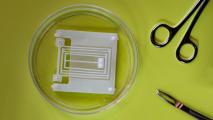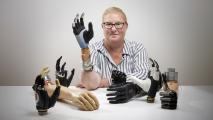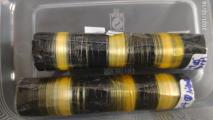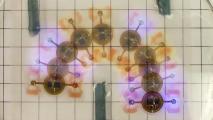A robot fish that swims by mimicking the contractions of the human heart has put scientists one step closer to growing full-size hearts in the lab.
The bizarre-sounding experiment has a very practical upshot: saving kids born with a deadly heart defect.
“Our ultimate goal is to build an artificial heart to replace a malformed heart in a child,” senior author Kit Parker, a professor of bioengineering and applied physics at Harvard University, said in a press release.
The challenge: Nearly 1% of babies are born with some sort of defect in their heart, and millions of other people will develop heart disease over the course of their lives — it’s the number one cause of death globally.
While some heart problems can be treated or cured with surgery, medication, and lifestyle changes, the only way to “fix” others is with a heart transplant — and the number of people in need of new hearts dramatically exceeds the number of donor hearts available.
Nearly 1% of babies are born with some sort of defect in their heart.
The idea: Lab-grown hearts could solve this shortage.
The basic idea is that doctors would take a patient’s cells, coax them into growing into a full-size heart in the lab, and then transplant the new heart back into the patient. Bonus: because the heart came from the patient’s own cells, organ rejection would be far less likely.
But while researchers have managed to create beating models of human hearts in lab dishes, the organs are incomplete and tiny — we’re talking one millimeter wide in some cases — and it’s hard to say whether this is the right way to grow complete, functional organs.
What’s new? The new robot fish is designed to clear up some of that mystery.
On each side of its tail fin is a layer of lab-grown human heart muscle cells. When the cells on one side contract, they pull the fin to that side. This causes the opposite side of the fin to stretch. That triggers the release of a protein that causes the cells on that side to contract.
A node that acts like a pacemaker keeps this back-and-forth rhythm going, and the movement propels the fish through the water.
By adding nutrients to the water, the researchers were able to keep the robot fish swimming for more than a hundred days, and they moved about as quickly and effectively as real zebrafish in the wild.
“Rather than using heart imaging as a blueprint, we are identifying the key biophysical principles that make the heart work, using them as design criteria, and replicating them in a system, a living, swimming fish, where it is much easier to see if we are successful,” Parker said.
In other words, they can see if their heart models really work how they’re supposed to.
The big picture: We still have a ways to go before scientists are transplanting lab-grown hearts into people, but the research leading up to that point can still help with the development of new drugs and therapies to treat heart disease.
And lab-grown hearts aren’t the only promising potential solution to the organ shortage problem — we also have researchers exploring the use of mechanical hearts, animal hearts, and even human hearts grown in animals.
We’d love to hear from you! If you have a comment about this article or if you have a tip for a future Freethink story, please email us at [email protected].






